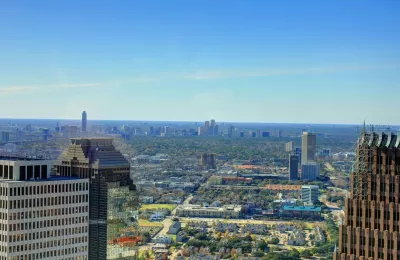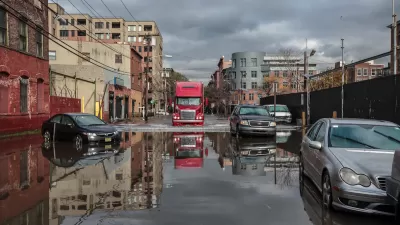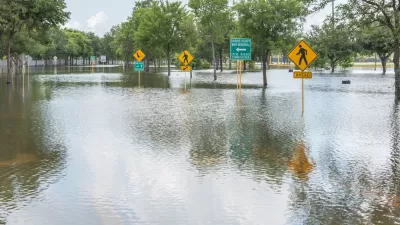Houston's director of Transportation and Drainage Operations wants to see more sustainable development in the city that has historically depended on freeways as its critical infrastructure.

Earlier this year, Houston experienced "one of the worst natural disasters in Texas history as a severe winter storm crippled infrastructure across the state." Veronica O. Davis, the city's new Director of Transportation and Drainage Operations, writes that the city "finds itself at a critical point."
Houston ranks as "one of the nation’s most unsafe for pedestrians and there is a wide gap between neighborhoods’ access to resources," says Davis. "For decades, federal transportation policy has added to these challenges by disproportionately encouraging and subsidizing the growth of one type of transportation infrastructure: highways, which receive 80 percent of federal transportation funding in the U.S." But there is another way. "By offering many ways to get around, we can help reconnect divided neighborhoods, provide more access to opportunity for all Houstonians, lessen racial inequities, and, with less concrete, have our neighborhoods flood less often." Davis says the city is making progress. "With the Resilient Houston plan, we are investing in drainage and green infrastructure to manage stormwater from major and minor storms. And under Mayor Sylvester Turner’s Complete Communities initiative, we are investing in Houston’s under-resourced neighborhoods — right-sizing roads to make them safer for people walking and biking, and working to reduce flooding."
But according to Davis, the city needs help from the federal government. Pointing to a proposal included in the House reconciliation package which includes $10 billion in funding for buses in underserved neighborhoods and "$4 billion to repair the historic damage to Black and low-income neighborhoods caused by highways that intentionally destroyed thriving places and widened segregation," Davis says "these targeted measures could be transformative, tying funding directly to goals, and giving local governments a greater say in what will most benefit their neighborhoods." To make progress on climate change and create a greener, more equitable city, "we must focus on transportation. We must take new approaches." The federal dollars could be a huge step in that direction.
FULL STORY: Opinion: Infrastructure can pave the way to a greener, fairer Houston

Study: Maui’s Plan to Convert Vacation Rentals to Long-Term Housing Could Cause Nearly $1 Billion Economic Loss
The plan would reduce visitor accommodation by 25,% resulting in 1,900 jobs lost.

North Texas Transit Leaders Tout Benefits of TOD for Growing Region
At a summit focused on transit-oriented development, policymakers discussed how North Texas’ expanded light rail system can serve as a tool for economic growth.

Why Should We Subsidize Public Transportation?
Many public transit agencies face financial stress due to rising costs, declining fare revenue, and declining subsidies. Transit advocates must provide a strong business case for increasing public transit funding.

How to Make US Trains Faster
Changes to boarding platforms and a switch to electric trains could improve U.S. passenger rail service without the added cost of high-speed rail.

Columbia’s Revitalized ‘Loop’ Is a Hub for Local Entrepreneurs
A focus on small businesses is helping a commercial corridor in Columbia, Missouri thrive.

Invasive Insect Threatens Minnesota’s Ash Forests
The Emerald Ash Borer is a rapidly spreading invasive pest threatening Minnesota’s ash trees, and homeowners are encouraged to plant diverse replacement species, avoid moving ash firewood, and monitor for signs of infestation.
Urban Design for Planners 1: Software Tools
This six-course series explores essential urban design concepts using open source software and equips planners with the tools they need to participate fully in the urban design process.
Planning for Universal Design
Learn the tools for implementing Universal Design in planning regulations.
Ascent Environmental
Borough of Carlisle
Institute for Housing and Urban Development Studies (IHS)
City of Grandview
Harvard GSD Executive Education
Toledo-Lucas County Plan Commissions
Salt Lake City
NYU Wagner Graduate School of Public Service





























